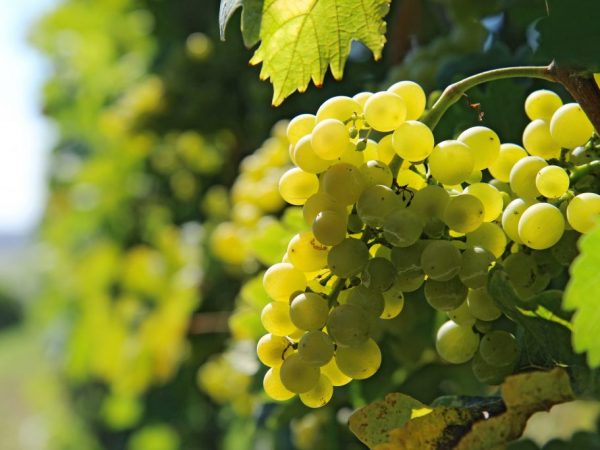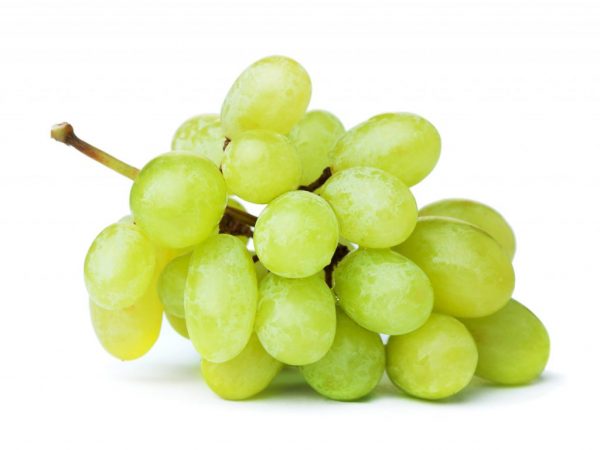Why white grapes are useful
The vine is popular for the beneficial substances contained in the fruit. One of the most common types of culture is white grapes. It covers almost 50% of all cultivated varieties.

The benefits of white grapes
Characteristics of white grapes
Vines are grown all over the world. White grapes are valued for their taste: they are used in winemaking, in the manufacture of raisins, they are consumed fresh, in conservation, in the cosmetic industry. A distinctive feature of white varieties is their light green color, acquired in the process of natural mutation of genes responsible for the synthesis of anthocyanins, the presence of which in large quantities makes the fruit darker.
White grapes are outwardly different from their darker cousins. The berries are of different shapes: they can be round, oval, elongated and even curved. Thin or thick skin, depending on the variety, can be covered with a waxy bloom. The pulp of white grapes is characterized by variability: from softness to hardness.
During ripening, the chemical composition of the fruit changes, which is expressed in a decrease in acidity, an increase in sugar content in berries, as well as complex essential oils.
According to hygienic standards, the content of various toxic elements and pesticides in grape berries must meet the standards. White grape varieties may be more susceptible to the negative effects of these substances, therefore, to maintain health, it is better to opt for healthy grapes grown organically. The rot present on the berries indicates the presence of fungal diseases, and therefore such fruits should be eaten with caution.
Varietal features
There is a division of grape varieties according to taste, which includes groups with ordinary (a combination of acidity and sweetness or neutrality), nutmeg (taste and aroma with a nutmeg hue), nightshade (herbaceous taste of nightshade berries), isable taste (strawberry, blackcurrant, pineapple) ...
The entire range of white grapes can be divided into 3 main groups according to the purpose of use. They represent the definition of taste and external characteristics, characteristics of the use of grapes, its value. Varieties can be:
- Dining rooms intended for ready-to-eat meals, as well as for preparing salads and desserts. This grape stands out for its taste: it is sweet, juicy, aromatic, its appearance is large bunches and large berries. The most famous representatives of the table grape are Valentine, White miracle, White giant, Maxi, White flame, Ladies fingers, Arcadia, White Kishmish.
- Technical ones used for winemaking. This white grape is characterized by a high percentage of juice in the berries, acidity or sugar content, thin skin, delicate strong aroma. The berry is intended for juicing, making sparkling and white wines of various strengths.The grapes of these varieties are strictly controlled and require special growing conditions. If, when drinking juice or a wine drink, rot is felt in it, it was made in violation of technological standards. The most common varieties are Aurora, Bianca, Siegerebe, Johaniter, Muscat, Aligota, Riesling, Pinot Blanc, Malvasia.
- Universal, or wine and dining rooms. Their properties make them suitable for both table consumption and wine making. For such purposes, use Aurora, Rkatsiteli, Muscat Ottonel, Albio.
Calorie content of white grapes

Berries increase appetite
There is no big difference in calories between white and dark grapes. However, white grapes are often sweeter. Eating white berries increases appetite, but even a late meal in the form of a bunch of grapes will not do any harm. The caloric value of white grapes differs depending on the variety:
- Seed grapes per 100 g of product has 60.3 kcal. A 100 gram serving contains 0.54 g protein, 0.04 g fat, 14.9 g carbs. The berry contains various vitamins and minerals, minerals and water.
- In varieties of healthy seedless grapes, 61.1 kcal are concentrated in 100 g. This amount of berries contains 0.5 g of protein, 0.1 g of fat, 15.1 g of carbohydrates. These grapes are often sweeter in flavor and safe for children.
The energy value of the product in the ratio of fats, proteins and carbohydrates (bju) is 3% / 8% / 86%. 1 kg of berries per day replaces 230 g of bread, 400 g of meat, 1 kg of potatoes or milk in terms of calorie content.
Beneficial features
White grapes are appreciated not only for their taste, but also for their rich chemical composition. It includes organic acids: malic, citric, tartaric, succinic. The taste of white homemade grapes convinces with the presence of saccharides, represented by glucose and fructose. An important indicator is the presence in the berries of a useful pectin substance, flavanoids (kakhetin and epikakhetin). White grape varieties are valued for their mineral and vitamin composition. They contain vitamins PP, B6, B2, B1, B9, H, K, C, A, E and minerals: potassium, phosphorus, silicon, boron, iron, vanadium, iodine, cobalt, copper, manganese, lithium.
Berries of white grapes and their constituents are used in the treatment of many diseases or to relieve symptoms. Also, the fruits have a diuretic, sedative, restorative, laxative, anticancer and antifungal effect. The beneficial properties of homemade white grapes support the treatment of the body in the following cases:
- The use of berries from 3 to 5 times a week in small quantities can prevent the development of heart and vascular diseases. Such a remedy serves as a prevention of the risk of blood diseases: anemia, thrombophlebitis, atherosclerosis, improves hematopoietic processes, increases the level of hemoglobin in the blood.
- The substances contained in the fruits strengthen the immune system, improve metabolism, and have a preventive effect against kidney and liver diseases.
- A large amount of fiber in berries helps to cleanse the body of toxic elements, blocking the harm they cause to internal organs and toxins.
- A bunch of grapes, eaten, affects the gallbladder, has choleretic properties, and removes sand.
- Berries improve your mood. Eating 10-15 berries a day helps to cope with apathy and depression, replenishes a person's energy supply.
- Thanks to the action of the components of white grapes, it is possible to reduce the risk of vision pathologies that occur at an older age: macular degeneration of the retina, cataracts.
- There is a significant benefit when eating berries with the appearance of cough, asthma, chronic tuberculosis. They improve the overall health of the lungs and airways.
- Small raisins turned into gruel are used as an ointment for lichen and itchy skin.
Conclusion
The characteristics of white grapes indicate that they are of great benefit to the body. Berries of white varieties are rich in many vitamins and microelements, have a high energy value. When using this product, attention is paid to the dosage, quality and the absence of allergic reactions, then the health and well-being benefits will be significant.


